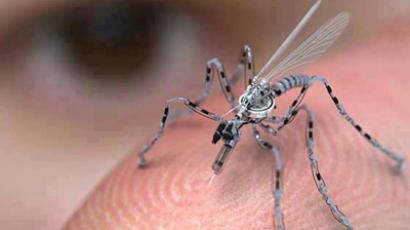Pentagon reveals DARPA's creepiest spy robot yet (VIDEO)

Researchers at the Pentagon’s DARPA lab are always on the lookout for new, exciting scientific marvels to creep out everyone on Earth. In their latest effort to do as much, they’ve succeeded with a small, color-shifting soft-shell robotic snail.
Researchers at the Defense Advanced Research Projects Agency, the Pentagon’s state-of-the-art science lab, have already brought us bite-sized drones and are hoping to have airplanes soaring at 20 times the speed of sound by 2016. In the meantime, though, they’ve revealed the results of another one of their latest projects sure to put everyone in a heightened state of paranoia.Video released last week by DARPA shows researchers controlling a small, low-cost silicone robot that relies on air and fluids to move across an array of terrain, using its surroundings to alter its color and temperature along the way.According to the info posted on DARPA’s YouTube channel, the soft silicon robot can crawl at a speed of only 40 meters per hour, but its ability to change color in just half a minute can allow it to be a useful spy agent that can sneak into areas undetected, “Future research will be directed at smoothing the movements; however, speed is less important than the robot's flexibility. Soft robots are useful because they are resilient and can maneuver through very constrained spaces,” the description reads.Their latest endeavor, the small, camouflage-capable silicon spy, is part of the agency’s Maximum Mobility and Manipulation (DARPA M3) Advanced Inflatable Robot (AIR) project. On DARPA’s official M3 webpage, they say that the goals of their program include being able to “Create a significantly improved scientific framework for the rapid design and fabrication of robot systems and greatly enhance robot mobility and manipulation in natural environments,” as well as “Significantly improve robot capabilities through fundamentally new approaches to the engineering of better design tools, fabrication methods, and control algorithms.”According to a press release on the M3 program’s latest achievements, they are on the verge of doing just that.“What DARPA has achieved with silicone-based soft robots is development of a very low cost manufacturing method that uses silicone molds,” the agency tells reporters. “The combination of low cost and increased capabilities means DARPA has removed one of the major obstacles to greater DoD adoption of robot technology.”Additionally, M3 Program Manager Gill Pratt adds that the soft silicon robot the agency is readying could be ones of the best achievements out of their lab yet.“DARPA is developing a suite of robots that draw inspiration from the ingenuity and efficiency of nature. For defense applications, ingenuity and efficiency are not enough—robotic systems must also be cost effective,” Gill says, according to The Capitol Column website. “This novel robot is a significant advance towards achieving all three goals.”














